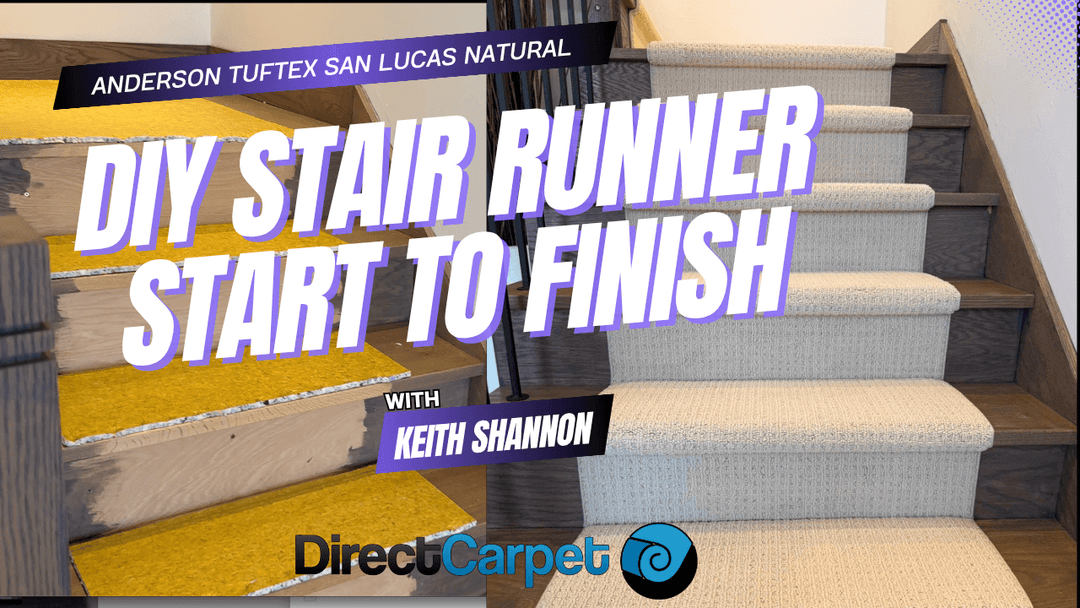How to Install a Stair Runner in a Few Hours!

How to Install a Stair Runner Fast!
Takeaway
-
What Size Staples do I need for My Stair Runner?
-
How to Install a Stair Runner in a Few Hours?
-
Stair Runner Benefits?
-
How to Measure for a Stair Runner Carpet?
-
Tools Needed to Install Your Stair Runner?
- List of Fast Ship Stair Runners
HOW TO INSTALL A CARPET RUNNER FAST!
Fitting and installing a stair runner on your staircase creates a stylish look in your house and can provide many other benefits, in your house in addition to being aesthetically pleasing. It Helps With Slips and Falls as well.
You may be surprised to know that with the right knowledge and installation tools, it is entirely possible to install a Stair Runner yourself.
Here is a look at the benefits of a stair runner carpet and how to install one.

WHAT IS A STAIR RUNNER, AND WHAT ARE THE BENEFITS?
A Stair Runner is a long strip of carpeting that can be purchased locally or purchased online in the Length and Width you desire.
A stair runner runs right down the middle of the stairs, leaving the exposed stairs visible on either side.
Normal-sized wood exposure is from 3 inches to 6 inches
Stair runners are typically installed on hardwood stairs over pads and have many practical benefits, typically including protecting the stairs, minimizing noise, and reducing the risk of slipping.
They can add a touch of style and flair to a plain staircase.
MEASURING AND CHOOSING YOUR STAIR RUNNER
You will need to measure your stairs to find out the exact length of stair runner carpet you will need.
A typical Stair Runner is 26 to 28 Inches Wide, and a Typical staircase has around 12.5 stairs. Each stair Measures in length around 18 inches. Times 12.5 (the Number of Stairs) x 18 inches (the Length of each stair) = 225 inches divided x 12 = 18.75 ft in total length.

How Much Stair Runner Carpet Do I Need for 12 Stairs?
Answer: 20 FEET
So if you had 12.5 stairs at 18 inches each, you would need around 20 feet of carpeting for your Carpet Runner!
When you make your choice of Carpet Runner, keep in mind that the material should be durable enough to withstand the heavy use on stairs that carpets are subjected to.
Also, you should consider that with a linear or geometric patterned Stair runner,
It will take more time and care to line up during carpet Installation. For complete novices, it may be best to stick to a plain Stair Runner, such as this Natural Artistry Raffia Basket Carpet Runner, which will be more forgiving for first-time DIYers.
Natural Artistry from Mohawk Industries is great for pets and kids because of its Smart Strand Technology (It's Pet Proof and Easy to Clean)

TOOLS NEEDED FOR A SMOOTH STAIR RUNNER INSTALLATION
After you have measured and obtained the correct length of the Carpet Runner, you'll need some additional tools to complete the installation, including a hammer, electric stapler/carpet stapler, Hammer Tacker, Tack Strips, Carpet Padding, Etc
1/ Roberts Electric Staple gun
6/ Hammer
A few honorable Mentions For Installing a Stair Runner are a tape measure a Sharp Pair Of Scissors a Pad Stapler
Get these ready beforehand and keep them handy throughout the process.

HOW TO INSTALL YOUR STAIR RUNNER?
First, you need to clean your wooden stairs. Pull any old Staples out, etc., and ensure the surface is ready for your Staircase Makeover.
1st Cut the carpet padding for the stair runner and place it on the stairs!
TOP TIP( Padding is Included when you purchase a Stair Runner Carpet from DirectCarpet.com )
TIP: (You'll want to cut the carpet padding to around 2 inches narrower than your Stair runner so you have room at the edges of each side to staple the Stair runner down)
Tack your Carpet Padding down using a hammer tacker!
It is recommended that you pad over the nose for extra Wear Protection, but it is not necessary!
TOP TIP: If your Carpet Runner is 28 Inches Wide, your Pad Needs to Be 26 Inches Wide.
Starting at the center and bottom of the stairs, use your tape measure to ensure the carpet runner is centered on the stairs.
Carefully measure each side, making sure the measurements are equal and that the bottom carpeting pad is centered underneath the padding.
Fold the edge of the Carpet Runner down to the bottom of the first stair, and using your Carpet Stapler, staple gun the edge along the carpet.
You will probably need 6 or 7 staples.
Tip: I Like to Staple Every 4 to 5 Inches!
You can then bring the carpet runner up, and you might find it helpful to pre-bend the carpet Runner so it curls nicely over the edge of the stairs.
You will need to staple the underside of the edge of the wood to ensure it fits smoothly as it goes up.
Using the carpet kicker tool, maintain pressure on the carpet runner to keep it flat and straight, and place a couple of carpet staples at each edge onto the bottom treads.
Then, using the carpet tucker in the corner where the bottom carpet treads first meet the riser, create a groove by moving it back and forth to make sure the carpet runner is fitting tightly and securely.
Then, staple along the groove to keep the corners of the carpet runner in place, just as you did at the start.
The first step is done, and the process needs to be continued up the staircase.
Taking your time, slowly move up the staircase walls, using the kicker to apply pressure to the walls. Stair Runner.
You don't want to have any excess carpet; the carpet should be tight enough that it is secure and not a trip hazard.
Staple carefully and ensure all staples are flat to avoid any sharp points sticking up.
As you move up the staircase, keep checking the measurements so you know that the Carpet is staying in the center of the stairs and the measurement is maintained on each side.
Staircases are often not straight, but it might be difficult to see by eye, so do keep checking the measurements.
If you need to join Stair runners, you can do this by cutting off any excess from where you staple along the back corner of the riser.
Take the new Carpet runner, fold the unfinished edge under, and then staple it along the edges of the room in the back so the runner seems to continue.
When you get to the top, simply cut off the excess carpet padding and staple it along the bottom edge of the lip of the top stair.
Once you've followed all these steps, your stairs will have a fabulous new look!
What Size Staples for a Stair Runner?
We Recommend 9/16 Crown Staples!
Carpet Padding
We Recommend 10 Mill Foil Top Padding!
Staple Gun
Pneumatic staple gun, Manual Staple gun, or Electric Stapler?
Pneumatic Staplers/ Very Popular Needs to Be Used with an Air Compressor. What sets them apart from the other staple guns is that they are smaller in size and can get into smaller spaces, and you can use 9/16th staples.
Electric Staple guns-/Electric Staple Guns are the Most Popular staple gun in use for installing carpet on stairs and carpet runners. And 9/16 staples are recommended for carpet installs!
Electric Staplers can be rented at any rental place, such as Home Depot or United Rentals
Manual Staple Gun/ Manual Stapler
A Manual Stapler has no trigger and is just hard to use lol, Very Popular before electric staplers came out! handy to have but honestly we never use it for Stair Runner Installs Anymore!
FREQUENTLY ASKED QUESTIONS
1. What Size Staples Should You Use for a Stair Runner?
Answer: You Should Use 9/16 Crown Staples to Install your Stair Runner!
2. How to Measure for a Stair Runner?
Answer: How to Measure for a Stair Runner
This Video by a Professional Carpet Installer, Keith Shannon, on YouTube will help you immensely and will show you exactly how to measure for your stair runner; this Video will show you the proper way to add up the number of your stairs and how to calculate how long and how wide your stair runner should be!
3: How Wide Should a Stair Runner Be?
Answer: Most Popular Width for a Stair Runner is 26 Inch Wide, 28 Inch Wide & 30 Inch Wide
4: How Much Does a Stair Runner Cost?
Answer: A Stair Runner Can Cost From $100 to $2000 Depending on The Quality of the Stair Runner and if You are Doing it Yourself or Hiring a Contractor!
For more on how to install a stair runner yourself, click here
Conclusion
Installing your very own stair runner can be fun as long as you know a few basic techniques such as how to measure your stair runner's length and width along with the proper Carpet padding to use, the proper tools to use, and where to rent them!
This Article was written by Keith Shannon, a Professional Carpet Insta;ler for over 25 years and owner at Directcarpet.com
Now all you need is a few great Stair Runners to choose from and here is a great place to start
Top 25 Stair Runners

More on how to install a stair runner yourself, click here
How to Install a Staircase Runner in 10 Steps?













Leave a comment